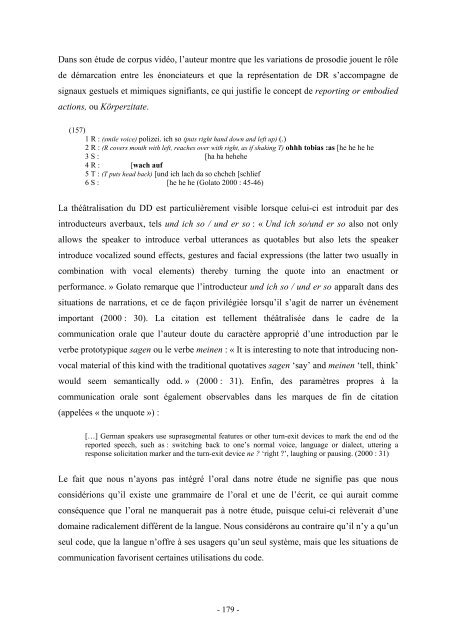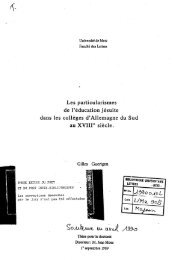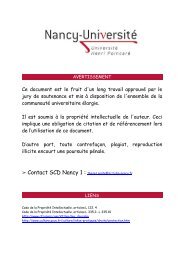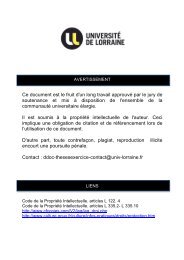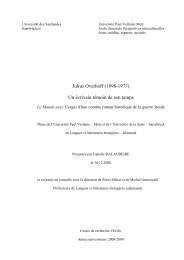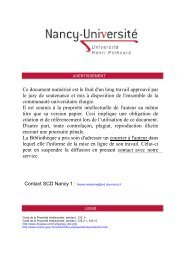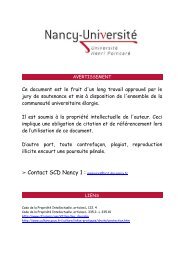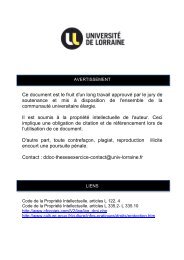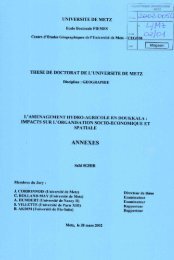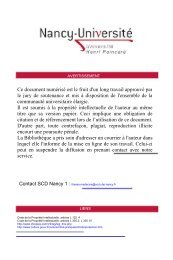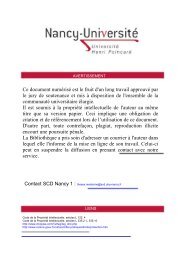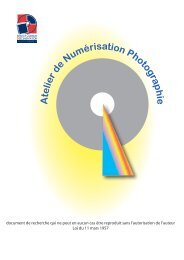- Page 1 and 2:
UNIVERSITE NANCY 2 UNITE DE FORMATI
- Page 3 and 4:
Sommaire INTRODUCTION _____________
- Page 5 and 6:
7.2.3.5 La traduction non lexicale
- Page 7 and 8:
des linguistes suisses Ch. Bally et
- Page 9 and 10:
type de corpus, S. Bastian et F. Ha
- Page 11 and 12:
traductologiques. Cette première i
- Page 13 and 14:
etenue en raison de l’existence d
- Page 15 and 16:
1.1.1 L’héritage de l’Antiquit
- Page 17 and 18:
Rahmenangaben des Autors und Figure
- Page 19 and 20:
Le fil rouge de Platon à Paul est
- Page 21 and 22:
D’autres articles de Benveniste o
- Page 23 and 24:
énoncé, les lieux d’inscription
- Page 25 and 26:
1.2.2 La proximité du discours rap
- Page 27 and 28:
1.3.1 Approches morpho-syntaxiques
- Page 29 and 30:
INDIREKTHEITSKONTEXTE sind Kontexte
- Page 31 and 32:
(1) Dieser Aufenthalt im Kunsthisto
- Page 33 and 34:
second (Authier-Revuz) ou reprise m
- Page 35 and 36:
(5) (Le narrateur a fait la connais
- Page 37 and 38:
(7) „Ich habe gestern abend noch
- Page 39 and 40:
opérés et une représentation don
- Page 41 and 42:
Rede » les discours rapportés com
- Page 43 and 44:
Il intervient également par diffé
- Page 45 and 46:
ner Nische, die beiden sind runter
- Page 47 and 48:
fügte, während ihr Gesicht sich a
- Page 49 and 50:
Intégration syntaxique Au discours
- Page 51 and 52:
On a observé tout au long du 20 è
- Page 53 and 54:
• Introducteurs neutres : lauten,
- Page 55 and 56:
Le discours second est à ce point
- Page 57 and 58:
du DI : le DD est la production d
- Page 59 and 60:
• Verbes performatifs Il n’est
- Page 61 and 62:
(57) Dann fragte sie, wie es denn m
- Page 63 and 64:
une substitution des termes du pré
- Page 65 and 66:
Cette forme de DR connaît beaucoup
- Page 67 and 68:
La même observation vaut pour la g
- Page 69 and 70:
• Environnement textuel Certains
- Page 71 and 72:
1.4.3.4 Le discours indirect libre
- Page 73 and 74:
L’absence d’enchâssement et de
- Page 75 and 76:
(76) [...] er wollte langsam reiten
- Page 77 and 78:
LUI - Oui, tu t’es fait peloter !
- Page 79 and 80:
D. Cohn (1969) a montré l’existe
- Page 81 and 82:
gardant la fluidité de l’express
- Page 83 and 84:
traductologiques ignorées que renf
- Page 85 and 86:
Perspective contrastive et traducto
- Page 87 and 88:
Dans la distance, Genette introduit
- Page 89 and 90:
1.5.2 Le modèle de Stanzel Le mod
- Page 91 and 92:
1.5.3 Bilan des deux modèles Les d
- Page 93 and 94:
ce dernier n’est jamais cité à
- Page 95 and 96:
(97) An einem Zahne... Senator Budd
- Page 97 and 98:
5) structure de dépendante à verb
- Page 99 and 100:
2 Le cadre contrastif et traductolo
- Page 101 and 102:
définit en relation avec la finali
- Page 103 and 104:
3) La troisième orientation de la
- Page 105 and 106:
L’ouvrage suivant du début du 20
- Page 107 and 108:
Dans l’armée des écrivains, nou
- Page 109 and 110:
L’incompatibilité supposée de l
- Page 111 and 112:
Malblanc (1963 : 16) pose la spéci
- Page 113 and 114:
première aide à prévoir, en amon
- Page 115 and 116:
A ces trois niveaux correspondent d
- Page 117 and 118:
La traduction est théoriquement im
- Page 119 and 120:
entendu comme produit d’une énon
- Page 121 and 122:
Ces propos reflètent le malaise pe
- Page 123 and 124:
Section II : Analyse contrastive Ce
- Page 125 and 126:
Le discours rapporté se définit c
- Page 127 and 128: caractéristiques de la situation d
- Page 129 and 130: (exemple suivant tiré de Die Klavi
- Page 131 and 132: So ne permet pas uniquement de rapp
- Page 133 and 134: 3.3.3 Les introducteurs averbaux du
- Page 135 and 136: Le dernier type d’accès à l’i
- Page 137 and 138: En français, une règle syntaxique
- Page 139 and 140: de certains genres de discours 130
- Page 141 and 142: 5.1 Les discours indirects introdui
- Page 143 and 144: zu entnehmen und wird individuell a
- Page 145 and 146: Correspondances entre certains empl
- Page 147 and 148: La différence est, selon Métrich
- Page 149 and 150: • La cohérence textuelle Un prem
- Page 151 and 152: • La substitution Un deuxième co
- Page 153 and 154: • Les valeurs de l’imparfait et
- Page 155 and 156: discours indirect embryonnaire, une
- Page 157 and 158: L’énoncé a) reste ambigu. Son s
- Page 159 and 160: formulées sur ce point dès l’or
- Page 161 and 162: partielles qui se complètent. Ball
- Page 163 and 164: Le Präteritum est plus apte à ins
- Page 165 and 166: kenne ? ». Selon nous, l’énonc
- Page 167 and 168: hybrides, allemandes et françaises
- Page 169 and 170: Günther (1928) propose une étude
- Page 171 and 172: secret se devait éviter ; / Qu’i
- Page 173 and 174: parole d’autrui qui se différenc
- Page 175 and 176: Section III : Analyse traductologiq
- Page 177: 4. En outre, la traduction est une
- Page 181 and 182: sera d’abord approfondi (9.1.1).
- Page 183 and 184: varier la représentation de l’é
- Page 185 and 186: Pour réaliser une équivalence dia
- Page 187 and 188: « Qu’est-ce qui t’ prend ? t
- Page 189 and 190: Corpus de so + énonciateur Texte s
- Page 191 and 192: Nature de l’équivalence et total
- Page 193 and 194: La traduction reproduit dans l’en
- Page 195 and 196: Selon peut être employé, car il n
- Page 197 and 198: L’impossibilité de choisir un in
- Page 199 and 200: Adam (2001a et 2004). Dans notre co
- Page 201 and 202: des événements. Le permis de séj
- Page 203 and 204: 7.2.3.4 Les verbes introducteurs av
- Page 205 and 206: Für Michel Nollet, den Vorsitzende
- Page 207 and 208: 8 Les discours indirects interprét
- Page 209 and 210: Dans le texte cible, l’énoncé
- Page 211 and 212: Die in erlebter Rede/erlebtem Denke
- Page 213 and 214: L’auteur de la deuxième traducti
- Page 215 and 216: In der ersten Zeit, als Charles sei
- Page 217 and 218: Umschlag, daß er ihre Durchtrieben
- Page 219 and 220: l’énoncé du texte source est un
- Page 221 and 222: - les colonnes récits, Bericht et
- Page 223 and 224: l’équivalence avec le DIL (Arjou
- Page 225 and 226: • Premier extrait Le premier extr
- Page 227 and 228: Etant donné que l’EIR marque dan
- Page 229 and 230:
où l’EIR est le seul équivalent
- Page 231 and 232:
équivalent de l’EIR, mais renden
- Page 233 and 234:
traductions de textes sources dans
- Page 235 and 236:
allemand et EIR se rejoignent et se
- Page 237 and 238:
total dix-huit interventions à l
- Page 239 and 240:
L’absence de DIL à l’imparfait
- Page 241 and 242:
Nous pensons que le DIL à la premi
- Page 243 and 244:
Walther dit qu’il avait une longu
- Page 245 and 246:
Des contextes différents permetten
- Page 247 and 248:
Mon père était toujours furieux c
- Page 249 and 250:
9.2 Analyse d’un corpus journalis
- Page 251 and 252:
l’Allemagne de « Saustall ». St
- Page 253 and 254:
strategischen Partnerschaft zugrund
- Page 255 and 256:
- des formes proches du récit, ég
- Page 257 and 258:
française Nita (2006 : 174) 189 qu
- Page 259 and 260:
être opérationnel début 2001. No
- Page 261 and 262:
jedoch im rationalistischen Konstru
- Page 263 and 264:
D’après le FMI, pourtant, il ne
- Page 265 and 266:
islamistischen Extremismus zustande
- Page 267 and 268:
L’emploi du conditionnel sans mod
- Page 269 and 270:
Zivilbevölkerung zu beurteilen. Au
- Page 271 and 272:
10 Bilan de l’analyse traductolog
- Page 273 and 274:
un genre interprétatif, l’ER. L
- Page 275 and 276:
Equivalence de l’erlebte Rede et
- Page 277 and 278:
Conclusion La première section ét
- Page 279 and 280:
d’asseoir en français la forme p
- Page 281 and 282:
sur le discours indirect libre embr
- Page 283 and 284:
Traduction française par Albert Ko
- Page 285 and 286:
Le Monde diplomatique Edité sur CD
- Page 287 and 288:
ZIEM Jochen, Die Einladung. Deutsch
- Page 289 and 290:
ARRIVE Michel, GADET Françoise et
- Page 291 and 292:
BLUMENTHAL Peter (1999), « Schéma
- Page 293 and 294:
COSERIU Eugenio (1978), « Falsche
- Page 295 and 296:
FOLKART Barbara (1986) : « L’opa
- Page 297 and 298:
HARRAS Gisela (2001), « Synonymie
- Page 299 and 300:
KLEIN Wolfgang (1991), « Was kann
- Page 301 and 302:
LERCH Gertraud (1922), « Die uneig
- Page 303 and 304:
MULLER Sylviane (2006), « (D)écri
- Page 305 and 306:
RECANATI François (1980), « Qu’
- Page 307 and 308:
STANZEL Franz Karl ( 7 2001/1979),
- Page 309 and 310:
YOS Gabriele (1997), « Benennungen
- Page 311 and 312:
den Matchball, und mit einem traumh
- Page 313 and 314:
Meine Mutter und ich hatten so kurz
- Page 315 and 316:
ehesten durch Zurückhaltung eine F
- Page 317 and 318:
erzählt? Kein Wort. Nur daß er Te
- Page 319 and 320:
- Jamais de la vie, mentez-vous ave
- Page 321 and 322:
L’idée de porter ce « syndicat
- Page 323 and 324:
Ce furent trois jours pleins, exqui
- Page 325 and 326:
Stand nicht geschrieben, daß die S
- Page 327 and 328:
anständiges Gesicht haben. Warum i
- Page 329 and 330:
Devoir „Hast du letzten Winter er
- Page 331 and 332:
Cette affirmation est abondamment i
- Page 333 and 334:
que la viande de bétail allait se
- Page 335 and 336:
dialogue », les Etats-Unis engager
- Page 337 and 338:
Interviewé, via son portable, dans
- Page 339 and 340:
Observateur attentif des comités b
- Page 341 and 342:
Extrapolant des tendances (trends)
- Page 343 and 344:
modernité-progrès qui prévaut es
- Page 345 and 346:
courrier électronique sur le lieu
- Page 347 and 348:
M. El Douri s’explique longuement
- Page 349 and 350:
2000-11 : 14 ; 15) Gesprächspartne


